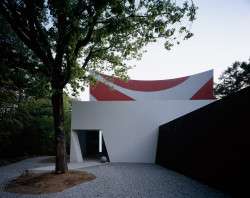
July 14, 2006
New Kyoto
Japan’s proud old capital gets a glimpse of its exciting future
By Metropolis
Originally published on metropolis.co.jp on July 2006

Courtesy of hyatt regency kyoto
Kyotoites hate change; they have an inherent mistrust of “new.” Given the disastrous monuments to modernization (a hideous tower, a gargantuan station) that litter the city’s once-serene skyline, it’s easy to see why. But the city is about to change, whether the people like it or not.
Japan’s return to economic growth has involved the internationalization of the economy, including tourism. It started in Tokyo with the entry of world-standard five-star hotels, which sent shockwaves through their domestic rivals. Those shockwaves are heading to second-tier cities, and Kyoto is next in line.
“Kyoto’s big hotels have tended to be bland and somewhat soulless places where the experience of being in Kyoto is hardly reflected,” says travel writer Simon Richmond, while famous ryokan can be too expensive or too formal.
The first company to spot this trend was Hyatt International, which in March opened the stunning, 189-room Hyatt Regency Kyoto in Higashiyama, next to Sanjusangendo temple. Amanresorts, owner of the Amanpuri in Phuket and other luxury properties, has also looked at sites in northwest Kyoto, near the Golden Pavilion, according to industry insiders, although nothing has been announced.

Courtesy of It’s Gion Deux
That Hyatt has its finger on the pulse should come as no surprise. This is the company that was a decade ahead of the pack when it opened the Park Hyatt Tokyo in 1994. Housed in a remodeled business hotel, the Regency’s rooms are small (meaning it can’t call itself a “Grand” or “Park”) but its facilities are top class.
courtesy of hyatt regency kyoto
Designed by Takashi Sugimoto of Super Potato, the rooms incorporate colorful panels covered with material from old kimono that contrast with understated wooden features and subtle furniture, and smart stone bathrooms. The jewel in Sugimoto’s kanzashi is Touzan, the Japanese restaurant and bar, broken up like the backstreets of an old town by glass panels decorated with fragments of pottery, masks, old-fashioned locks and pieces of machinery. At the entrance is a vast, black washi paper wall sculpture Sugimoto crafted in a parking lot in Yokosuka, imprinted with the shapes of curbs, gutters and manholes. For Kyoto, it’s revolutionary.
At first, the locals reacted to this unorthodox upstart with typical disinterest. “There were bound to be some local grumbles, Kyotoites generally being a notoriously snobbish and culturally precious lot,” says Richmond. They favor the Okura and always have.
But maybe not for long. The Hyatt’s restaurants are starting to attract locals as culinary destinations in their own right, according to executive chef Matthew Crabbe. Trattoria Sette has an irresistible buzz and some of the best Italian food in the city (the start-up chef was seconded from the Grand Hyatt in Shanghai, and his local replacement has high standards to maintain); Touzan is exquisite in every regard.
Locals have also embraced the hotel’s spa, Riraku, still a novelty in a city where “spa” usually means “onsen.” Despite its functionally clinical design, Riraku is heavily booked on weekends with Kyotoites trying facials, massages and acupuncture.
Outside of the hotel, there are pockets of creativity blossoming in corners of the city that can be explored with the help of a Kyoto Navigator map, available at design shops and cafés. At the Cocon department store in Kawaramachi, there are stylish outlets selling incense and washi; in the north of the city, there is the cozy Keibunsha book store, a mecca for designers; even in the heart of Gion there are funky bars like the oddly named It’s Gion Deux. Designed like the inside of a lantern, the bar overlooks a stream in the heart of the old geisha district, and serves up cocktails with a distinct taste of déjà vu. It used to be the Iwanami, a delightful cheap ryokan run by a tiny old woman who hoisted futons into cupboards like she was 30 years younger. She retired, and her ryokan was turned into a string of mini style-bars.
It’s sad when unique old places like the Iwanami close, but also exciting when exceptional new ones like the Hyatt open. Yes, Kyoto is about to change, but there is no need for its people to be afraid.
Published per-room rates at the Hyatt Regency Kyoto are ¥35,000 for the standard guest room, ¥65,000 for the beautiful deluxe balcony suite, and ¥91,000 for the executive suite, which includes a tatami meeting/dining room, but may vary depending on the booking dates. See www.kyoto.regency.hyatt.com for details or call 075-541-1234. Higashiyama can be explored by foot from the hotel, which is a short taxi ride from Kyoto Station and downtown areas such as Kawaramachi. Keihan Shichijo subway station is a 5min walk. Cocon (www.coconkarasuma.com) houses a branch of the Karacho washi shop (www.karacho.co.jp) and Lisn (www.lisn.co.jp) for incense. Keibunsha (www.keibunsha-books.com) is a 5min walk west of Ichijoji station on the Eizan line. It’s Gion Deux (www.itsinc-jp.com) is in Sueyoshi-cho in Gion and has a cover charge starting at ¥1,000 per person. Reserved-seat tickets from Tokyo to Kyoto on the shinkansen are ¥13,520 each way; buses from Shinjuku are ¥4,300 each way.
[geo_mashup_map]







